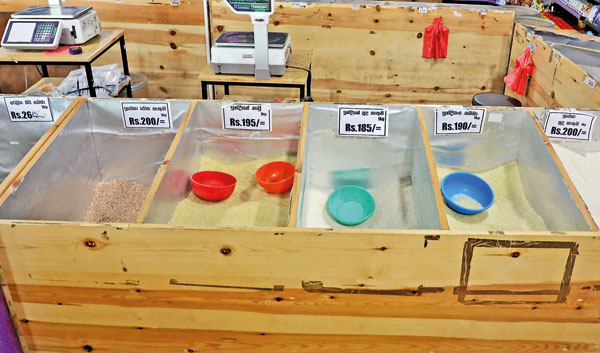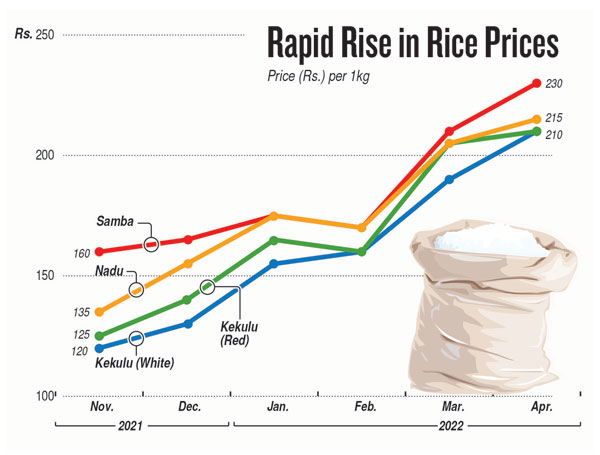News
Shortage of rice imminent, warn small scale rice millers
- Price of 1kg of rice could increase to Rs. 400 by end August
- Paddy yields drop by 50 percent; rice imports become mandatory
The country is in the midst of a worsening financial and essential items shortage crisis, with fears that it could go bankrupt as inflation reaches new highs, food prices skyrocket and the country’s foreign reserves run dry.
One of the main issues that is gradually growing is the impending shortage of the staple food; rice in the market. A steady stream of buyers trickles into the leading supermarket chains and groceries to buy rice at a much higher price.
The price of 1kg of rice could be doubled from the current price and it will increase up to Rs. 400 by end August, the Small and Medium Scale Mill Owners’ Association warned.

Prices have increased exponentially in the past 6 months. Pic by M.A. Pushpa Kumara
“In another month and a half, there will be a clear shortage of rice in the market due to the lack of harvest in the Maha season. The government has to import more than one million metric tonnes of rice this year,” Muditha Perera, Secretary of Small and Medium Scale Rice Millers Association, warned.
He said paddy yields have been reduced by about 50 percent; accordingly, rice imports have become mandatory. “However, this will be the main reason behind the quit of 95 percent – small and medium scale rice mill owners from their profession,” he said.
The government has already imported over 400,000 mt tons of rice in the past four months. Rice is also being offered under a credit line of USD 1 billion announced by India recently towards the purchase of essential commodities, and according to the Ministry of Trade USD 150 million is earmarked for rice supplies to Sri Lanka.
Mr. Perera said due to the ongoing power crisis, the SME sector was not able to grind paddy properly, during the New Year season. “As a result, by the end of April, we may see some shortage of local rice in the market,” he said.
Gimhani, a housewife, went to replenish her food stocks from a leading supermarket for the upcoming days amid reports of food shortages. “I have come to buy rice. The stocks are very much available, but the issue at the moment is price, which have almost doubled,” she said.
The displayed rice prices are fluctuating when it comes to the market prices, the consumers claimed. As per the figures by the Central Bank of Sri Lanka (CBSL), there is a Rs. 10 – 20 increase in rice prices within two weeks, between March end and April 12 (New Year’s week); and this is a concerning situation when it comes to food scarcity and inflation.
According to the statistics released by the CBSL, in the last six months, prices of staple food items; especially rice, have increased exponentially causing major food scarcity and an increase in food inflation. (Please see graphic)
The rice price increase and the impending shortage in particular, seems to be self-inflicted misery wrought upon by ill-conceived plans to ban chemical fertilisers by the Government pushing farmers to grow organic crops despite the warning by agriculture scientists that the move may severely affect production of essential food items like rice. 
The policy implemented in 2021, sought to cut down on fertiliser subsidies to the tune of USD 260 million, according to the facts shared by Agriculture Minister Mahindananda Aluthgamage earlier. However, the amount is less than 1 percent of the total Gross Domestic Production (GDP) of the country. After farmers’ protests, the fertiliser ban was withdrawn in November 2021 and recently Prime Minister Mahinda Rajapaksa accepted that moving to organic fertiliser was not a timely move and the Government will continue to provide fertiliser subsidies to the farmers. However, the damage had already been done. The steep fall in production triggered a sharp rise in food inflation which had hit 25 percent by February this year.
Although efforts are being made to obtain the required fertiliser for the Yala season, it will take about one and a half months to receive the fertiliser. The Government has failed to import fertiliser due to the current foreign exchange crisis and the rice shortage in the market is clear, the All Ceylon Farmers Federation Head Namal Karunaratne warned.
A severe shortage of agriculture sector workers will also impact the local production of rice in the upcoming months since most of the farmers are not willing to engage in farming in the Yala season.
“We are not able to engage farmers to work on paddy fields due to the fertiliser issue. The farmers managed to get some harvest since they had previous chemical fertiliser stocks in hand but now they are unable to purchase any kind of fertiliser,” he said.
M. Ratnayake, a paddy farmer from Hambantota area who used to cultivate more than one acre land of paddy is now out of fertiliser stocks and he was not able to complete half of his cultivation.
“The widely used Urea fertiliser 50kg bag is selling at Rs. 40,000 in some places; how can we manage to cultivate our lands in this state. Only thing we can do is to quit farming,” he said. Farmers in the North Central region also warned that there won’t be anything to eat by the end of August this year due to the shortage of fertilizer.
Farmers from Elahera in Polonnaruwa, an area dominated by paddy cultivation claimed that the ill-treatment by the authorities at a time where their farmlands have been devastated with no proper fertilizer to yield the hard toiled harvest.
The best way to say that you found the home of your dreams is by finding it on Hitad.lk. We have listings for apartments for sale or rent in Sri Lanka, no matter what locale you're looking for! Whether you live in Colombo, Galle, Kandy, Matara, Jaffna and more - we've got them all!

